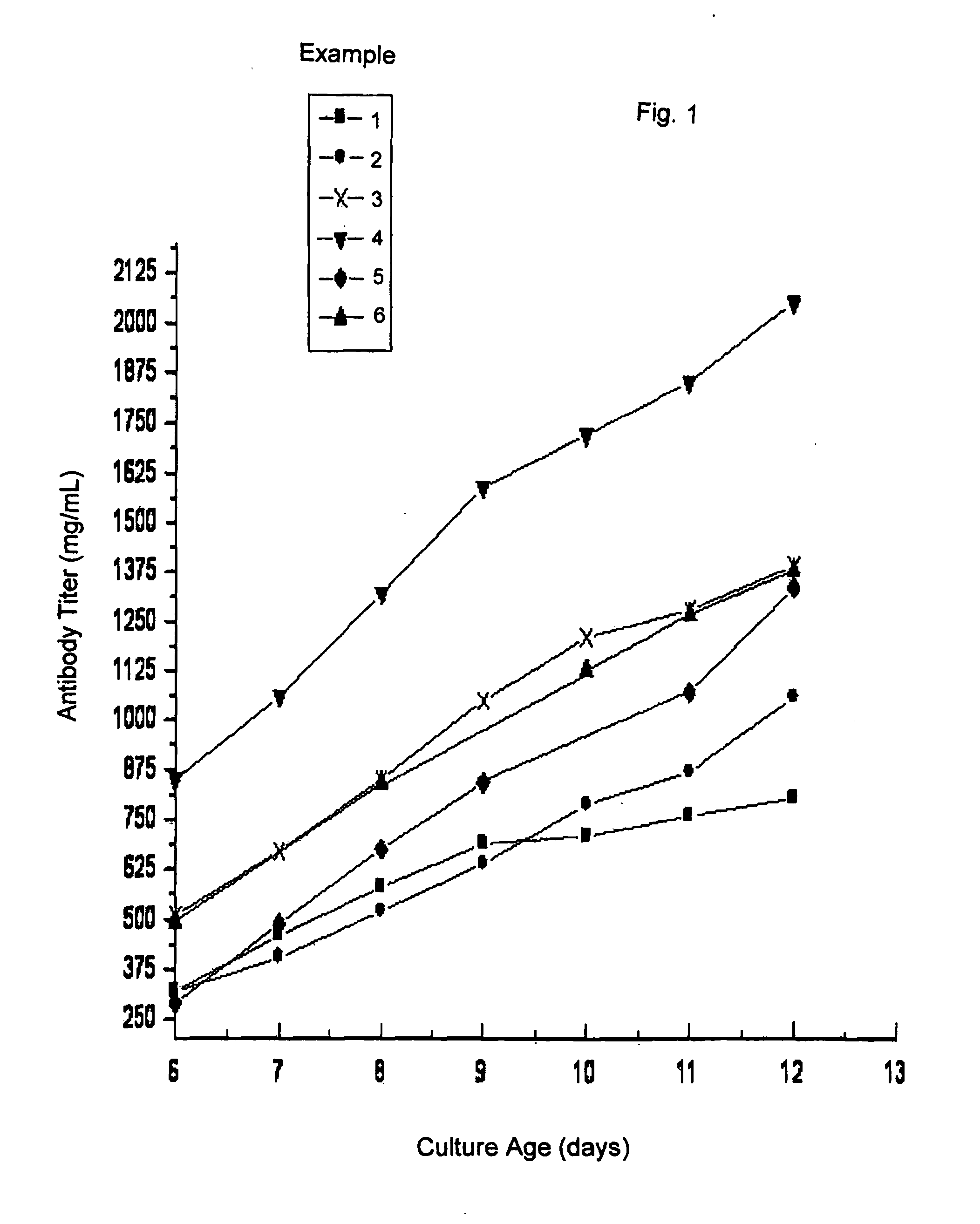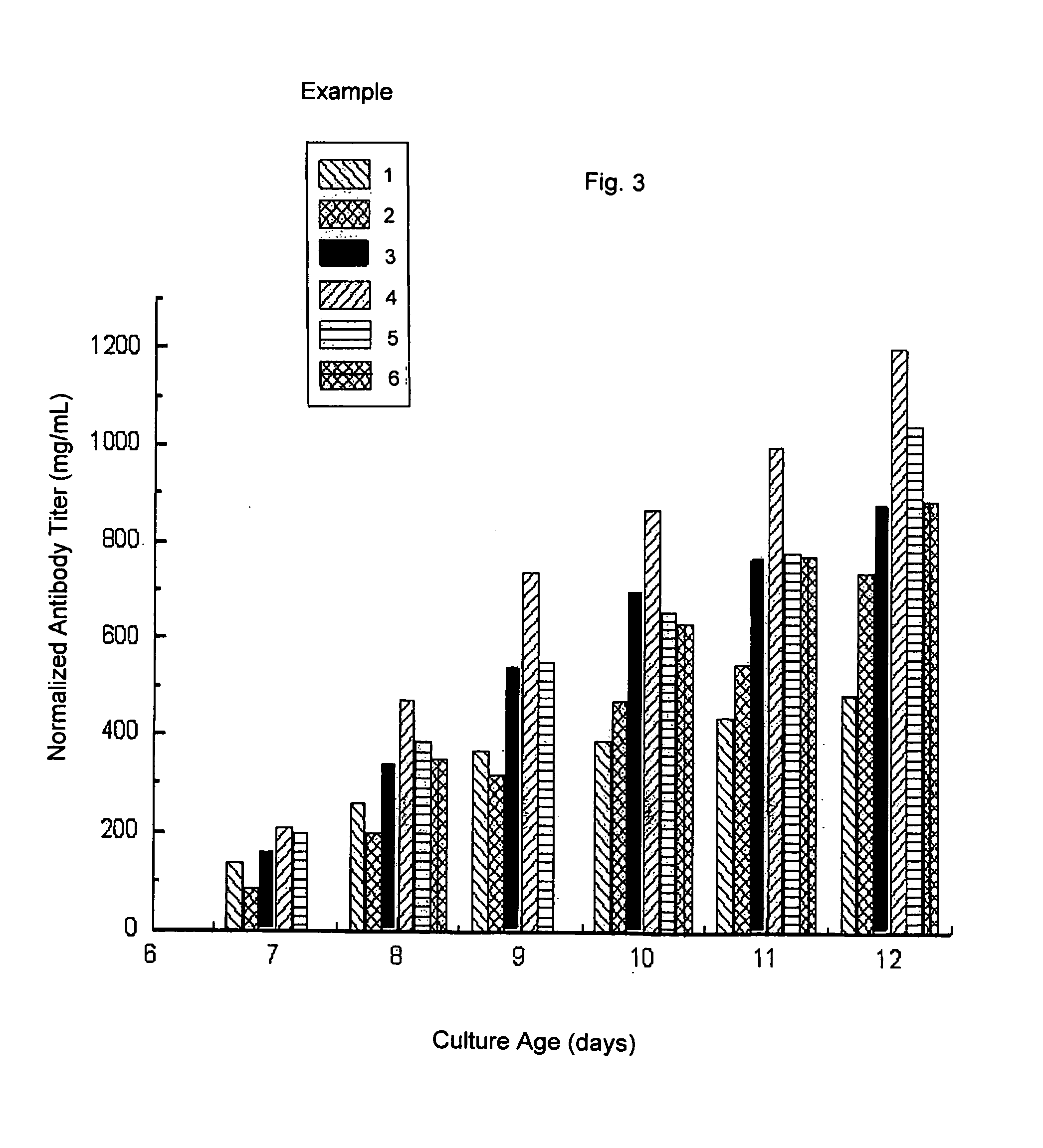Enhanced protein expression
a protein and expression technology, applied in the field of enhanced protein expression, can solve the problems of variability in the results, difficulty in biomolecule manufacturing, and difficulty in developing cost-effective and efficient industrial scale production of recombinant proteins, and achieve the effects of enhancing heterologous protein production, reducing temperature, and increasing osmolar values
- Summary
- Abstract
- Description
- Claims
- Application Information
AI Technical Summary
Benefits of technology
Problems solved by technology
Method used
Image
Examples
example 1
[0044]An anti-VEGF antibody was cloned and expressed in a CHO cell line as described in U.S. Pat. No. 7,060,269, which is incorporated herein by reference. rCHO cells expressing antibody at a seeding density of 0.2-0.6 million cells / mL were grown in a PF CHO (HyClone®, Catalog no. SH30335 and SH30334) at 37° C. and an initial osmolality of 380-390 mOsm / kg. On attainment of optimum cell growth (IVCC of 3 to 12 million cell-days / mL), the osmolality was increased to about 420 mOsm / kg and the temperature was lowered to 33° C. The culture was finally harvested after 288 hours or at 550% viablility. The resulting antibody yield was determined.
[0045]The antibody yield and cell viability are disclosed in Table 1.
[0046]FIGS. 1 and 2 include illustrations of the “antibody titer” and viable cell count (VCC) profiles obtained by the procedure described in this example. The lines marked “1” represent the antibody titer and the VCC profile for this example.
[0047]FIG. 3 is an illustration of the “...
example 2
[0048]An anti-VEGF antibody was cloned and expressed in a CHO cell line as described in U.S. Pat. No. 7,060,269. rCHO cells expressing antibody at a seeding density of 0.2-0.6 million cells / mL were grown in a PF CHO (HyClone®, Catalog no. SH30335 and SH30334) at 37° C. and an initial osmolality of 380-390 mOsm / kg. On attainment of optimum cell growth (Ivcc of 3 to 10 million cell-days / mL), the osmolality was increased to ≧450 mOsm / kg and ≦550 mOsm / kg and the temperature was lowered to 33° C. The culture was finally harvested after 288 hours or at 550% viablility. The resulting antibody yield was determined.
[0049]The antibody yield and cell viability are disclosed in Table 1.
[0050]FIGS. 1 and 2 include illustrations of the antibody titer and viable cell count profiles obtained by the procedure of this example. The lines marked “2” represent the antibody titer and the VCC profile obtained.
example 3
[0051]An anti-VEGF antibody was cloned and expressed in a CHO cell line as described in U.S. Pat. No. 7,060,269. rCHO cells expressing antibody at a seeding density of 0.2-0.6 million cells / mL were grown in a PF CHO (HyClone®, Catalog no. SH30335 and SH30334) at 37° C. and an initial osmolality of 320 mOsm / kg. During the growth phase, profile feeding of nutrients was done to increase the osmolality from 320 mOsm / kg to about 410 mOsm / kg (at 72 hours). On attainment of optimum cell growth (Ivcc of 3 to 10 million cell-days / mL), the osmolality was increased (by addition of nutrients and salts) to ≧450 mOsm / kg and ≦550 mOsm / kg and the temperature was lowered to 33° C. The culture was finally harvested after 288 hours or at greater than 50% viability and the resulting antibody yield determined.
[0052]The antibody yield and cell viability are disclosed in Table 1.
[0053]FIGS. 1 and 2 are illustrations of the antibody titer and viable cell count profiles obtained by the procedure of this exa...
PUM
| Property | Measurement | Unit |
|---|---|---|
| osmolality | aaaaa | aaaaa |
| osmolality | aaaaa | aaaaa |
| osmolality | aaaaa | aaaaa |
Abstract
Description
Claims
Application Information
 Login to view more
Login to view more - R&D Engineer
- R&D Manager
- IP Professional
- Industry Leading Data Capabilities
- Powerful AI technology
- Patent DNA Extraction
Browse by: Latest US Patents, China's latest patents, Technical Efficacy Thesaurus, Application Domain, Technology Topic.
© 2024 PatSnap. All rights reserved.Legal|Privacy policy|Modern Slavery Act Transparency Statement|Sitemap



